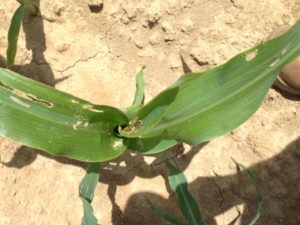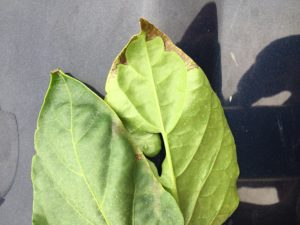Sweet Corn
Very low numbers of European corn borer (ECB) moths were again captured this past week, but not enough to generate a map image. These individuals likely represent the onset of a second flight. New feeding should occur after an increase in adults.
Growers should continue to scout whorl and pre-tassel stage plantings weekly and consider treating when infested plants exceed 12% in a 50 plant sample. As plantings proceed to the pre-tassel stage, ECB larvae may be found in emerging tassels. It is a good idea to treat individual plantings as they move into the full tassel/first silk stage one time. This eliminates any ECB larvae that have emerged with the tassels as they begin to move down the stalk to re-enter near developing ears.
Useful insecticides for this particular application include synthetic pyrethroids (IRAC Grp 3), spinosyns (including OMRI approved Entrust) IRAC Grp 5), and diamides such as Coragen (IRAC Grp 28) or materials such as Besiege which include the active ingredient in Coragen. Synthetic pyrethroids alone should NOT be used for corn earworm (CEW) protection on silking corn. Control with these materials is very inconsistent.
The highest nightly trap catches of ECB for the week ending 7/10/19 are as follows:
| Crosswicks 1 |
| Dayton 1 |
| Matawan 1 |
| Sergeantsville 1 |
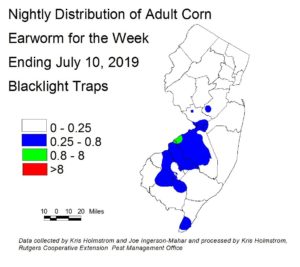 Corn earworm (CEW) moth catches in both trap types increases slightly over the past week(see blacklight map at left, and pheromone trap map below at right). Although CEW activity is generally low at this time of the season, frequent periods of southerly air flow may be assisting adults’ movement into our area. Catches from North Carolina are variable and not particularly high, while Delaware’s catches are similar to our southern NJ catches. None of these catches indicate that a large scale migratory influx is underway. Overall, numbers are fairly low here, with the majority of activity below Mercer County. Green areas on the pheromone trap map indicates a 4-5 day silk spray schedule. Blue areas represent a 5-6 day schedule, and white areas
Corn earworm (CEW) moth catches in both trap types increases slightly over the past week(see blacklight map at left, and pheromone trap map below at right). Although CEW activity is generally low at this time of the season, frequent periods of southerly air flow may be assisting adults’ movement into our area. Catches from North Carolina are variable and not particularly high, while Delaware’s catches are similar to our southern NJ catches. None of these catches indicate that a large scale migratory influx is underway. Overall, numbers are fairly low here, with the majority of activity below Mercer County. Green areas on the pheromone trap map indicates a 4-5 day silk spray schedule. Blue areas represent a 5-6 day schedule, and white areas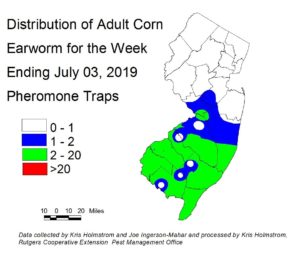 are 6-7 day. There are far fewer CEW pheromone traps than blacklights, and the resulting map has much broader color bands as a result. It should also be noted that the pheromone traps are much more sensitive than blacklights. Therefore, the number of moths caught in pheromone traps required to generate a specific spray interval is much higher than the number caught in blacklight traps. It must be stressed that there is high variability in these catches, and growers should consult with their IPM practitioner on recommended spray schedules.
are 6-7 day. There are far fewer CEW pheromone traps than blacklights, and the resulting map has much broader color bands as a result. It should also be noted that the pheromone traps are much more sensitive than blacklights. Therefore, the number of moths caught in pheromone traps required to generate a specific spray interval is much higher than the number caught in blacklight traps. It must be stressed that there is high variability in these catches, and growers should consult with their IPM practitioner on recommended spray schedules.
The highest nightly trap catches of CEW pheromone trap catches for the week ending 7/10/19 are as follows:
| Pedricktown 22 | Beckett 6 | Jobstown 5 | South Branch 2 |
| Woodstown 22 | Berlin 6 | Elm 4 | Crosswicks 1 |
| Eldora 11 | Green Creek 6 | Monroeville 4 | Matawan 1 |
Fall Armyworm
Fall armyworm (FAW) are feeding in some Cape May County sweet corn fields. This pest causes extensive foliar damage on whorl stage corn (see photo above at left), can also infest ears, and is capable of killing small plants. For this reason, regular field scouting of all plantings including seedling stage corn is necessary. FAW larvae are brown in color (see photo below at left), with an inverted “Y” pattern on their head capsule. They are much larger than ECB when fully developed. FAW is even more consistently resistant to pyrethroid insecticides. For this reason, the same insecticides classes now recommended for  CEW control should be utilized for FAW management.
CEW control should be utilized for FAW management.
Silking Spray Schedules*:
South – 4 days
Central – 5-6 days
North – 6 days
*These recommendations are based on regional catches. Adhere to tighter spray schedules if indicated by local trap catches. To repeat: Synthetic pyrethroids alone should NOT be used for corn earworm (CEW) protection on silking corn, or for fall armyworm (FAW) management at any stage. Control with these materials is very inconsistent.
Tomatoes
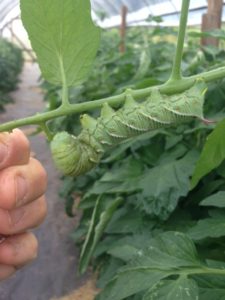 IPM technicians have noted increasing numbers of tomato hornworms (THW) in high tunnel tomato plantings this week. These caterpillars (see photo at right), can cause unacceptable levels of damage to foliage and green fruit in high tunnels, while they are rarely a significant problem in the field. If evidence (stripped leaves, droppings or actual hornworms) of these pests are found at multiple sites in the high tunnel, consider control. This can be by hand picking or with insecticides like Coragen (IRAC 28) or Entrust (IRAC 5 – OMRI approved).
IPM technicians have noted increasing numbers of tomato hornworms (THW) in high tunnel tomato plantings this week. These caterpillars (see photo at right), can cause unacceptable levels of damage to foliage and green fruit in high tunnels, while they are rarely a significant problem in the field. If evidence (stripped leaves, droppings or actual hornworms) of these pests are found at multiple sites in the high tunnel, consider control. This can be by hand picking or with insecticides like Coragen (IRAC 28) or Entrust (IRAC 5 – OMRI approved).
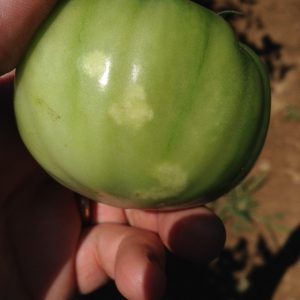 We are entering the period of the growing season when stinkbug activity in tomato fields increases, and higher levels of feeding have been reported by technicians. These insects feed on fruit, causing the characteristic “cloudy spot” injury (see photo at left). Stinkbug nymphs cannot fly, and will feed extensively on fruit in discrete locations. Often picking crews detect feeding first, due to the volume of fruit they handle. If feeding is increasing or immature stinkbugs are detected in fields, or adults are detected at more than one site in a ten site sample, consider insecticide applications to limit injury. Consult the Tomato Section of the 2019 Commercial Vegetable Recommendations for suggested materials.
We are entering the period of the growing season when stinkbug activity in tomato fields increases, and higher levels of feeding have been reported by technicians. These insects feed on fruit, causing the characteristic “cloudy spot” injury (see photo at left). Stinkbug nymphs cannot fly, and will feed extensively on fruit in discrete locations. Often picking crews detect feeding first, due to the volume of fruit they handle. If feeding is increasing or immature stinkbugs are detected in fields, or adults are detected at more than one site in a ten site sample, consider insecticide applications to limit injury. Consult the Tomato Section of the 2019 Commercial Vegetable Recommendations for suggested materials.
As yet, no pepper weevils have been captured on traps placed near southern NJ pepper fields.
Bacterial leaf spot infections are occurring with more frequency throughout the state. Dark lesions at the leaf margins, with a water-soaked appearance are typical of this disease (see photo at right). If lesions occur on young leaves that have not fully expanded, the leaves will distort as they mature. Plants will begin to drop infected leaves, resulting in a higher potential for sun scald on the fruit. Growers should consult the Pepper Section of the 2019 Commercial Vegetable Production Guide for suggested treatments, and maintain adequate fertility to the plants to encourage new canopy growth.
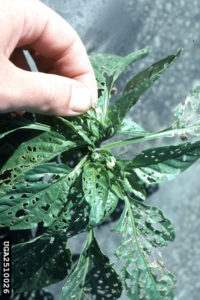 Pheromone traps established for beet armyworm (BAW) in the southern counties have begun catching adults. At this time, most activity is in the Woodstown area (11/night), although low numbers have also occurred near East Vineland (2) and Jones Island (4) in Cumberland County. This pest can reach levels that result in damage to pepper plants, although this does not occur each year. Growers in Cumberland and Salem counties should be alert for the appearance of severely defoliated terminals (see photo at left) on pepper plants. Small BAW larvae feed on these leaves before turning to fruit as they increase in size. As with FAW, beet armyworm is resistant to pyrethroid insecticides. Insecticides now recommended for CEW and FAW control are useful for BAW management.
Pheromone traps established for beet armyworm (BAW) in the southern counties have begun catching adults. At this time, most activity is in the Woodstown area (11/night), although low numbers have also occurred near East Vineland (2) and Jones Island (4) in Cumberland County. This pest can reach levels that result in damage to pepper plants, although this does not occur each year. Growers in Cumberland and Salem counties should be alert for the appearance of severely defoliated terminals (see photo at left) on pepper plants. Small BAW larvae feed on these leaves before turning to fruit as they increase in size. As with FAW, beet armyworm is resistant to pyrethroid insecticides. Insecticides now recommended for CEW and FAW control are useful for BAW management.
Pumpkins and Winter Squash
Note that cucurbit downy mildew (CDM) was discovered on cucumber in Salem County last week, as per Dr. Andy Wyenandt’s Pest Alert of 7/4/19. Most races of this disease infect cucumber, and we experience CDM on this crop each year. Other cucurbits are at risk from specific strains. For this reason, we maintain sentinel plots of various cucurbits so that growers know which types are threatened. To date (7/10/19), CDM has not been reported on other cucurbit crops in NJ, and the sentinel plot now established at Snyder Farm in Hunterdon County is free of disease on all crop types. Nonetheless, all growers should be scouting for CDM on all cucurbit crops at this time. For regional information on this important disease, see the Cucurbit Downy Mildew Forecast webpage: http://cdm.ipmpipe.org/. This weeks’ forecast has NJ at minimal risk risk (after Monday) of infection from sources to our south.
